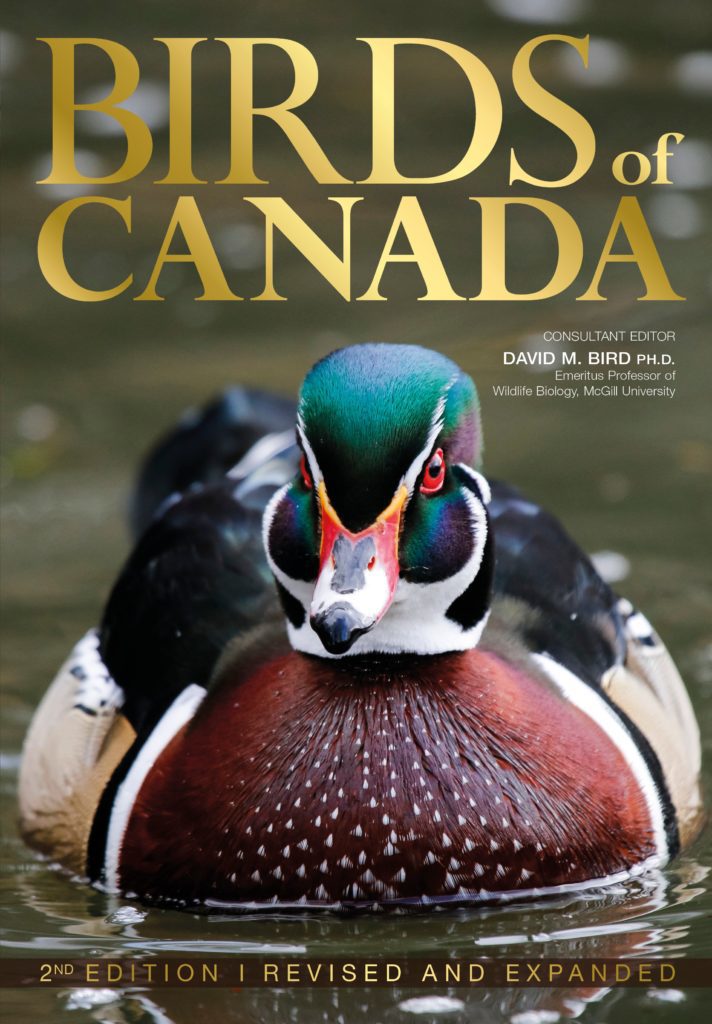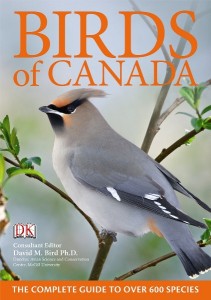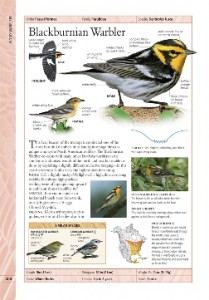Birds of Canada 2nd Edition
 While retaining all the best features of the first edition, this revised book brings you completely up to date with all the changes in bird world. I know of no other book that combines beautiful feature pages to help you identify birds with the newest scientific information. If you’re a birder in Canada, you need this book!
While retaining all the best features of the first edition, this revised book brings you completely up to date with all the changes in bird world. I know of no other book that combines beautiful feature pages to help you identify birds with the newest scientific information. If you’re a birder in Canada, you need this book!
The full page profile pages remain the same, and continue to be the most useful of any bird guide. Not only do they help you identify the bird, they show you similar species (extremely helpful) and teach you a bit about the life of the bird.
While the birds themselves never change, their ranges and scientific status often do. I was particularly glad to see a new full page profile of the White-faced Ibis, for example. These magnificent birds have been expanding their range northward and can now be found in many areas of southern Alberta.
The Common Gallinule has replaced the Common Moorhen in the book. The Common Moorhen used to comprise various subspecies that ranged through Europe and NA, and the NA species has now been split off into its own separate species with a new name of Common Gallinule.
The Pacific Wren is a new species split off from the Winter Wren.
Six species have moved from the vagrant birds to the rare birds section. Four new species have been added to vagrant birds.
Name changes:
Whip-poor-will is now Eastern Whip-poor-will
Yellow Wagtail is now Eastern Yellow Wagtail
Nelson’s Sharp-tailed Sparrow is now Nelson’s Sparrow
Ringed Plover is now Common Ringed Plover
Taxonomic changes:
Gannets and Cormorants used to be classified with Pelicans under the order Pelecaniformes, and now they are part of the order Suliformes and have been moved out of the Pelicans chapter into their own chapter.
Ibises and Herons have been added to the Pelicans chapter as they have been moved to the order Pelecaniformes
The Birds of Prey chapter has been split into two, as a number of the birds have been moved out of the Falconiformes order into the Accipitriformes order. Now one chapter covers Hawks, Eagles, and Vultures (Accipitriformes), and the other chapter covers Falcons (Falconiformes)
Longspurs and Snow Buntings have been moved out of the Sparrows chapter into their own, as they have been moved to a new family Calcariidae from the family Emberizidae
The biggest change is in the Wood Warblers chapter, where many Warblers formerly in the Dendroica genus were moved to the Setophaga genus.
———————–
 Birds of Canada is a treasure, with over 1000 full-colour images, and 512 pages covering over 600 species. Birds don’t respect political boundaries, and call the entire continent home. While the information in this book covers all of North America out of necessity, unlike other North American field guides, it does not list species we will never see here. No need to flip through hundreds of extraneous species found only in Texas or Florida. These are the birds we can expect to see in our own country.
Birds of Canada is a treasure, with over 1000 full-colour images, and 512 pages covering over 600 species. Birds don’t respect political boundaries, and call the entire continent home. While the information in this book covers all of North America out of necessity, unlike other North American field guides, it does not list species we will never see here. No need to flip through hundreds of extraneous species found only in Texas or Florida. These are the birds we can expect to see in our own country.
Full page profiles cover 435 of the most commonly seen Canadian species; quarter page profiles cover an additional 30 rare species such as Eurasian Wigeons; and a chart lists accidental visitors, including where they might be seen in Canada.
The full page species profiles also contain information not found in other bird guides. Their conservation status in Canada is listed at the bottom of the page, although I could find no reference as to which authority they are citing.
One of the most useful elements – particularly for sparrows and warblers – is the Similar Species box. Colour photographs, complete with field marks, identify birds that closely resemble the bird featured on that page. The profile for the Lincoln’s Sparrow, for example, lists the Song Sparrow as being larger overall with coarser streaking, and the Savannah Sparrow as having a yellow stripe above the eye.
 Flight patterns are also included for each bird. Additional captioned photographs show the bird in its typical habitat, or exhibiting typical behaviour. Colour-coded bands on the outer edges of the pages are arranged by family, making it easy to quickly search by flipping through the pages.
Flight patterns are also included for each bird. Additional captioned photographs show the bird in its typical habitat, or exhibiting typical behaviour. Colour-coded bands on the outer edges of the pages are arranged by family, making it easy to quickly search by flipping through the pages.
This book would be invaluable in identifying that new bird while in the field, except for one thing – no one is going to take this book on a bird watching trip. It measures 7.5 x 11” (19 x 28 cm) and weighs 3.5 pounds (1.6 kg). No one I know is going to lug that much weight around in addition to binoculars, scopes, cameras etc.
The wealth of information on evolution, anatomy, migration, courtship and mating, nests and eggs make this book more of an encyclopedia than a field guide.
Whether it is a field guide, an encyclopedia, a guidebook or a handbook, however, the Birds of Canada book now has a very special place on my bookshelves. If you’re a Canadian interested in birds, it should be on yours too.
Birds of Canada, David M Bird, Ph.D.ed



I love this book! It is an excellent reference guide and a beautiful coffee table book.
i love birds so much im 9 years old and i already saved 2 a chikadee and a pigon at school i love birds
What an excellent idea. I’ve been using the book a lot for the fall warblers and juvenile sparrows in my yard, but it’s easy to use when it’s sitting on my kitchen counter!
Too bad that the data/photo’s in this book has not, so far, been digitalized for use on the iPhone or iPad. The iPhone would be an excellent way to overcome the books weight and size while actually doing “birding”.